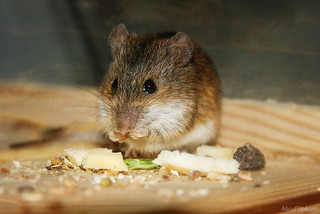How Do Mice Get into Houses?
By Chris Williams on July 8, 2014.
 So you’ve got mice. You’re working on getting rid of them but you’re trying to figure out how they got in in the first place. There are so many possibilities and they vary depending on the construction and the condition of your home. You just might need professional help.
So you’ve got mice. You’re working on getting rid of them but you’re trying to figure out how they got in in the first place. There are so many possibilities and they vary depending on the construction and the condition of your home. You just might need professional help.
Probably the most common way that mice get into homes is through the garage door. Garage doors rarely seal tightly at the bottom and sides, especially at the bottom corners (see “Maintain Your Garage Door to Keep Mice Out”). Other ways that mice get inside is through vents or rotting soffits near the roofline, around openings left where utility or cable lines enter near the foundation, through gaps around lower level doors or windows especially when door thresholds or sweeps are missing, through damaged foundation or crawlspace vents, by climbing up inside porch support columns, etc., etc.
Finally, sometimes mice are simply carried in…by the cat, in a potted plant, in boxes from the shed, or in firewood. Remember, if a mouse finds an opening on your house that is not big enough, she will gnaw at it until she can fit through. Once inside, mice can go pretty much wherever they want in a home by moving through wall or ceiling voids, and following pipes and utility lines.
Sometimes, Mice Are Born in Your Home
Of course, every mouse that you see in your house did not come in from outside. They were probably born in your house. All it takes is for one pregnant female to find her way inside and you’ll seen have a breeding indoor population. Now if you’re pretty sure you’ve eliminated mice in your house and sometime later you see a mouse again, that’s a clue that you need to do some mouse-proofing to keep them out.
Mouse Exclusion Work Can Solve the Problem
Mouse-proofing or mouse exclusion is simply sealing all of the entry points on your house that mice can use to get inside (see “Mouse-proofing Your Home – Advice From the Pros”). Examples of mouse-proofing jobs are repairing or replacing screens, screening attic and foundation vents, caulking cracks and other openings around foundations, adding thresholds, sweeps, and weather stripping to doors, caulking around conduit and plumbing entry points, repairing or reinforcing soffits, and so on. Since mice are tiny and openings are usually plentiful, especially in older homes, mouse exclusion can be a time-consuming job. Some professional exterminators, like Colonial, can do that job for you.
Photo credit: AlicePopkorn / Foter / Creative Commons Attribution-NoDerivs 2.0 Generic (CC BY-ND 2.0)